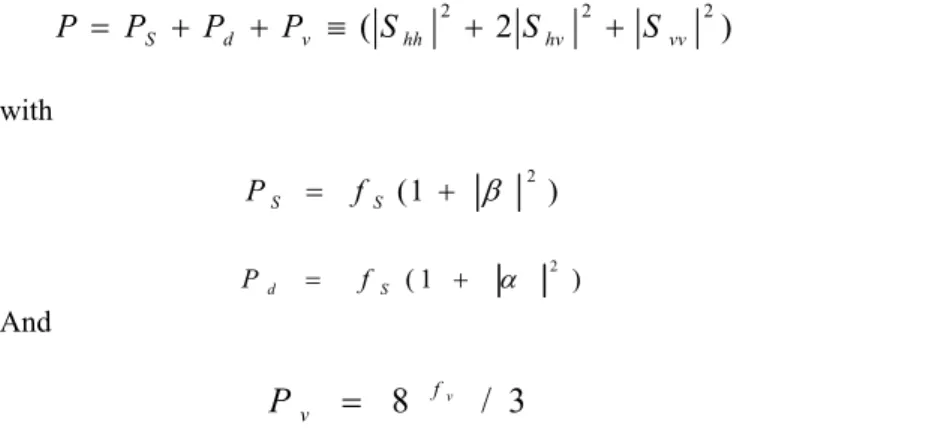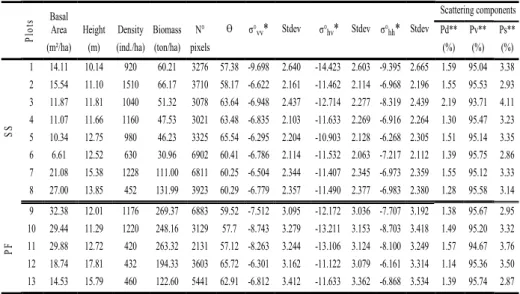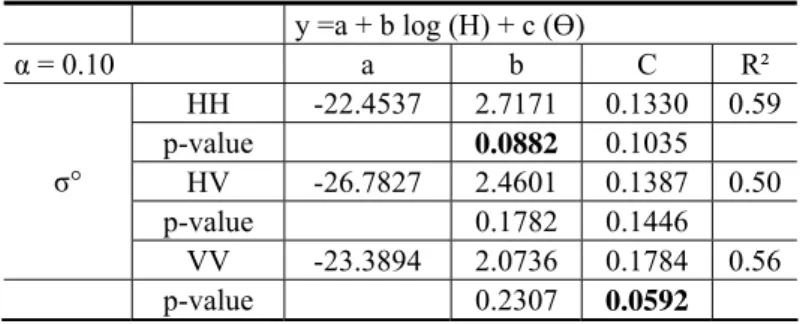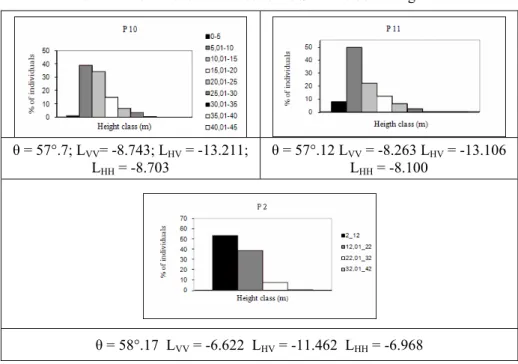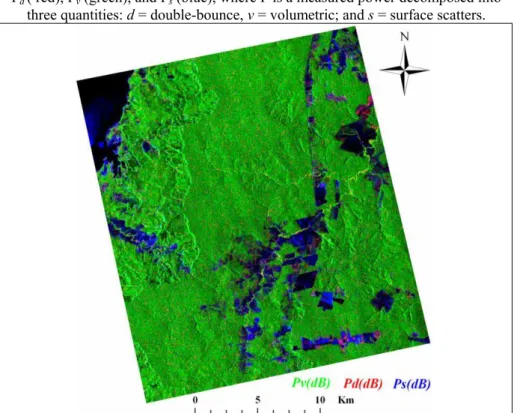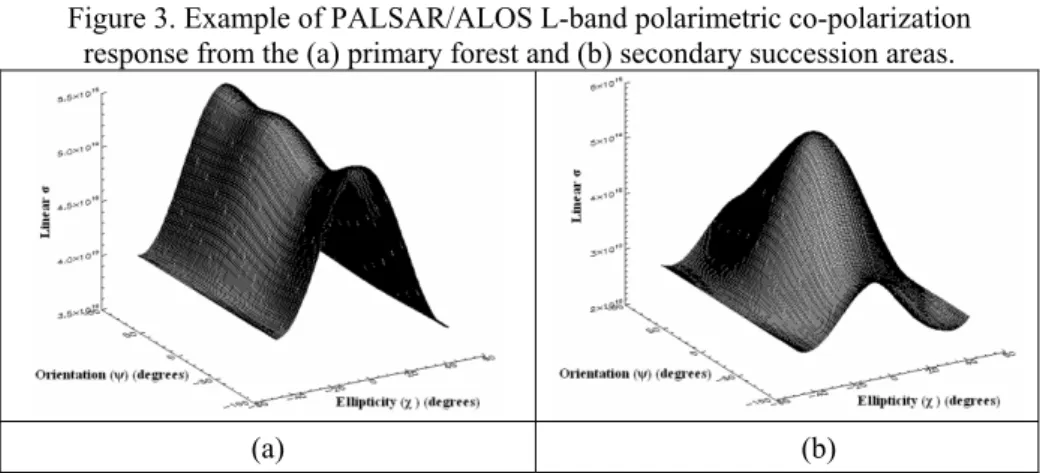ANALYSIS OF STRUCTURAL PARAMETERS OF FOREST
TYPOLOGIES USING L-BAND SAR DATA
Análise dos parâmetros estruturais de tipologias florestais utilizando dados SAR em banda L
IGOR DA SILVA NARVAES¹ JOÃO ROBERTO DOS SANTOS¹ ARNALDO DE QUEIROZ DA SILVA¹
National Institute for Space Research – INPE/MCT Av. dos Astronautas, 1758.
CEP: 12.227-010 - São José dos Campos, SP – Brasil email: {igor, jroberto, arnaldo}@dsr.inpe.br
ABSTRACT
The main objective of this work is the investigation of the relationship between the polarimetric L-band backscatter (σº) from different incidence angles (collected by the airborne sensor R99-B/SIPAM) and the structural parameters of the primary and secondary forest typologies. The area under study is located at the Tapajós National Forest and surroundings (Pará State, Brazil). Using the Freeman-Durden target decomposition technique, the basic backscatter mechanisms are presented to verify the contributions of the physiognomic-structural components of these forest stands in the L-band signal responses. As a conclusion, it is possible to verify that the variable “tree height” has better relations with the backscatter values, when compared to other structural variables, especially when the model also includes variations of the incidence angle of the stripes imaged. The Freeman-Durden decomposition technique indicates that the volumetric scattering component has the strongest influence on the L-band at primary and secondary tropical forests at incidence angles between 52 and 70 degrees, mainly due to the high incidence angle and, consequently the low depth vertical penetration.
Analysis of structural parameters of forest typologies using ... 4 7 6
RESUMO
O objetivo principal desse trabalho é investigar a relação entre o retroespalhamento (σ°) de dados SAR polarimétricos de banda L, em diferentes ângulos de incidência (coletado pelo sensor aerotransportado R99-B/SIPAM) e os parâmetros estruturais de sítios de floresta primária e sucessão secundária. A área selecionada para esse estudo está localizada na região da Floresta Nacional do Tapajós (Estado do Pará, Brasil) e áreas circunvizinhas. É utilizada a técnica de decomposição de alvos de Freeman-Durden na avaliação dos mecanismos básicos de espalhamento, para verificar a contribuições das componentes fisionômico-estruturais dos alvos florestais na resposta-radar de banda L. Como conclusão, é possível verificar que a variável “altura das árvores” teve melhor relação com os valores de retroespalhamento, quando comparado com outras variáveis biofísicas, especialmente quando o modelo também incluiu variações do ângulo de incidência na direção em range. A técnica de decomposição de Freeman-Durden indicou que a componente volumétrica de espalhamento tem uma forte influência na resposta em banda L para florestas tropicais primárias e secundárias,em ângulos de incidência entre 52 e 70 graus, devido principalmente ao elevado ângulo de incidência e, consequentemente a baixa profundidade de penetração vertical da onda incidente. Palavras-chave: Inventário Florestal; SAR; Banda L; Mapeamento; Floresta Tropical; Amazônia.
1. INTRODUCTION
Narvaes, I. S. et al. 4 7 7
HAJNSEK et al., 2009). Studying the values of backscatter features (σ0), the penetration capacity and the predominant scattering mechanisms on vegetation as well as biomass evaluation from multi-frequency and multi-polarized AIRSAR data, it was verified that bands PHV and LHV are more sensitive to the total biomass,
presenting furthermore a strong relation with some structural forest parameters such as height (H), basal area (G), and diameter (DBH) (MOUGIN et al., 1999). Nevertheless variations in the floristic composition, forest structure and management practices can have an important effect on the results (HOEKMAN and QUINÕNES, 2000). The high correlation among biomass and L- σ0hh and σ0hv,
saturated at 100ton/ha for both polarizations was found by WATANABE et al.
(2006) at a temperate coniferous forest. The same authors, using the target decomposition of Freeman and Durden (FREEMAN and DURDEN, 1998) to generate a scattering model of each tree component, where volume scattering is around 80-90%, when the biomass exceeds 50 ton/ha. For younger stands the component of surface scattering is of around 20%, and the volumetric scattering components are below 70%. Yet, in according to WATANABE et al. (2006), the origin of the dependency among the forest species was examined for the σ0HH–
above-ground biomass. It is concluded that a possible cause of the dependency is the different characteristics of the stands rather than forest species.
The objective of this research is to analyze the relation of the L-band scattering with structural aspects from primary forest and secondary succession stages, including the effect of the variations of the incidence angle on the response of the investigated forest targets. Additionally an analysis is made on the contribution of the scattering mechanisms on the forest targets using the Freeman-Durden decomposition technique. The selected area under study is located in the region of Tapajós (Brazil), with the geographical coordinates S 3º 01’ 59.85” to S 3º 10’ 39.33” and WGr 54º 59’ 53.08” to WGr 54º 52’ 44.96”.
2. MATERIAL AND METHODS
Analysis of structural parameters of forest typologies using ... 4 7 8
sufficient amount of pixels representative for the theme, reducing so the statistical uncertainties and the influence of speckle noise (WATANABE et al., 2006).
The evaluation of the basic scattering mechanisms was done using the polarimetric decomposition technique of Freeman-Durden, for the incoherent targets, applied to the complex images, which allows estimating the absolute contribution from each one of three physical mechanisms (double-bounce, surface and volumetric scattering). For volume scattering, it is assumed that the radar return is from a cloud of randomly oriented, very thin, and cylinder-like scatters (Li-wen et al., 2007); double-bounce conditions is modeled by scattering from a dihedral corner reflector, where the reflector surface can be made of different dielectric materials; surface scattering is derived by a first-order Bragg modeling. According to FREEMAN and DURDEN (1998), the scattering contribution is obtained by the following expressions:
fv fd fs
Shh2 = β2+ α2+
(1)
fv fd fs
Svv2 = + +
(2)
3 /
* fs fd fv
ShhSvv = β+ α+
(3)
3 / 2
fv
Shv =
(4)
The three-component scattering model based on covariance matrix has been successfully applied to decompose polarimetric SAR image (Zhang et al., 2008), under the reflection symmetry condition:
. 0 * * = ShvSvv = ShhShv
(5)
The final scattering contribution is obtained whether double-bounce or surface scatter is the dominant contribution in the residual, based on the sign of the real part of (Shh S*vv). If Re (Shh S*vv) is positive, the surface scatter is dominant and fix α = -1 .If Re (Shh S*vv) is negative the double- bounce scatter is dominant in the remainder and fix =1.Then fs, fd and or α can be estimated from the residual radar measurements. This approach will obviously work best when either fs or fd
are close to zero, or when α or are close to -1or +1.
Narvaes, I. S. et al. 4 7 9
) 2
( hh 2 hv 2
v d
S P P S S
P
P = + + ≡ + + Svv 2
(6)
with ) 1 ( + = S S f
P β 2 (7)
) 1
( +
= S
d f
P α 2
v f (8) And
3
/
8
vP
=
(9)where fv, fd and fs are the contributions to the power from volume, dihedral, and surface scattering, respectively. Additionally, the coefficient α and β are the parameters that can be estimated from some forest variables, such as trunk radius and tree number density. According VAN ZYL (1989), it enables us to identify the contribution of each scattering mechanism only from SAR polarization data, without any field data. Applying this technique we obtained the percent values of the scattering mechanisms over each of the sampled areas (ROI).
The biophysical parameters were collected in 5 areas of primary forest (each plot = 2,500 m2) and 8 areas of secondary succession (each plot = 1,000 m2), positioned geographically with a GPS. It is import to inform that height (H) and diameter at breast height (DBH) measure, which allowed generating the basal area and biomass values of the secondary succession, were collected during 2002. At this specific case of regrowth, in order to reduce the effect of the time imbalance between the field survey (2002) and the SAR imaging (2005), a correction factor was applied to the field inventory data, calculated on the average intervals of tree height and diameter. Such stratification was defined considering the height and DBH intervals from 3 m and 3 cm for the secondary succession respectively. This allowed establishing the average yearly increment by class of interval, considering the recovery age of each plot of secondary succession. The specific allometric equations for biomass estimation for the primary forest (BROWN et al., 1989) and secondary successions (UHL et al., 1998) were used.
3. RESULTS AND DICUSSIONS
3.1. Backscatter versus biophysical parameters
Analysis of structural parameters of forest typologies using ... 4 8 0
secondary succession areas, which represent intermediate and advanced phases (characterized by the old regeneration age and also by the vertical structure) present σ0
hh = -7.38 dB± 2.34, σ0hv = -11.95dB ± 2.27 and σ0vv = -7.06dB ± 2.29. The values found in this study are coherent with those obtained by Hoekman and Quiñones (2000), SAATCHI et al. (1997), SANTOS et al. (2002), whose variability can be attributed to general differences in the horizontal and vertical structure of the strata from the forest typologies. This also shows that the sensor SAR-R99B presents an adequate radiometric response.
The analysis of the backscattering, for both primary forest and secondary succession samples, shows that there are, in most of the cases different values for the co-polarizations and a stronger backscatter at VV and HH than HV. The return signal is more reduced at the cross-polarization, which is more sensitive to volumetric scattering (random distribution of branches, twigs and leaves. The relation between polarizations and biophysical parameters was evaluated by simple linear regressions.
The analysis of the backscatter of the 13 ROIS considers not only the
physiognomic-structural characteristics of the forest types, but also the incidence angle (Ө) of the imaging. Since the imaging swath of the SAR R99-B was of 30 Km, and the incidence angle varies between 52. and 70.1°, the sampled plots are located, from near to far range between 57° and 65° (Table 1). There is a little increase tendency of σ°HH and σ°VVwith the increment of the Ө value. A possible
explanation for this phenomenon is related with the combination to the radar wavelength, polarization and incidence angle. According to VAN DER SANDEN (1997) the L-band interact more with the primary branches and secondary branches and tree trunks – wavelength effect – for the polarization state the σ°HH and σ°VV
have high interaction with the horizontal components in the crown to the secondary forests which are in more dense in general and vertical components (mainly trunks) at the primary forests. However, it interactions is controlled mainly by the low incidence angles which maintain the waves (L-band) interaction on the random scattered elements (branches) in the different crown strata of primary and secondary forest, as proved to the same authors which say “the depth of vertical penetration (δp) will decrease with an increase in incidence angle (θinc)”. The most relevant
Narvaes, I. S. et al. 4 8 1
Table 1 - Coherent and incoherent attributes SAR L-band data for sites and respective biophysical parameters of forest typologies.
Pl
o
ts Basal Area
(m²/ha) Height
(m) Density (ind./ha)
Biomass (ton/ha)
N° pixels
Ө σ°vv* Stdev σ°hv* Stdev σ°hh* Stdev
Scattering components
Pd** (%)
Pv** (%)
Ps** (%)
SS
1 14.11 10.14 920 60.21 3276 57.38 -9.698 2.640 -14.423 2.603 -9.395 2.665 1.59 95.04 3.38 2 15.54 11.10 1510 66.17 3710 58.17 -6.622 2.161 -11.462 2.114 -6.968 2.196 1.55 95.53 2.93 3 11.87 11.81 1040 51.32 3078 63.64 -6.948 2.437 -12.714 2.277 -8.319 2.439 2.19 93.71 4.11 4 11.07 11.66 1160 47.53 3021 63.48 -6.835 2.103 -11.633 2.269 -6.916 2.264 1.30 95.47 3.23 5 10.34 12.75 980 46.23 3325 65.54 -6.295 2.204 -10.903 2.128 -6.268 2.305 1.51 95.14 3.35 6 6.61 12.52 630 30.96 6902 60.41 -6.786 2.114 -11.532 2.063 -7.217 2.112 1.39 95.75 2.86 7 21.08 15.38 1228 111.00 6811 60.25 -6.504 2.344 -11.407 2.345 -6.973 2.359 1.55 95.12 3.33 8 27.00 13.85 452 131.99 3923 60.29 -6.779 2.357 -11.490 2.377 -6.983 2.380 1.28 95.58 3.14
PF
9 32.38 12.01 1176 269.37 6883 59.52 -7.512 3.095 -12.172 3.036 -7.707 3.192 1.38 95.67 2.95 10 29.44 11.29 1220 248.16 3129 57.7 -8.743 3.279 -13.211 3.153 -8.703 3.418 1.49 95.20 3.32 11 29.88 12.72 420 263.32 2131 57.12 -8.263 3.244 -13.106 3.124 -8.100 3.249 1.57 94.67 3.76 12 18.74 17.81 432 194.33 3603 65.72 -6.301 3.162 -11.122 3.079 -6.161 3.314 1.14 95.36 3.50 13 14.53 15.79 460 122.60 5441 62.91 -6.812 3.412 -11.633 3.362 -6.868 3.534 1.39 95.74 2.87
PS: The incoherent attributes* is based only in the measures of radar power, while the coherent attributes** aggregate the beyond it the phase (HENDERSON and LEWIS, 1998). Table 2 shows the R² values and one verifies that the variable “tree height” (average height values of trees within the stand of each plot) presented solely the best relation with the σ0hh when compared with the other biophysical variables.
Generally the tree height is correlated positively with the forest biomass and volume till the saturation point. This indicates that the higher the trees and the larger the canopies, the stronger is the amount of scattering elements in the resolution cell (ROI) and consequently there is a higher backscatter, at a positive correlation. However, this variable must be evaluated jointly with incidence angle. The relation between σ0hh and tree height tends to be high due mainly to the low capacity the
Analysis of structural parameters of forest typologies using ... 4 8 2
Table 2 - Coefficient of determination (R²) among structural aspects and backscatter coefficients.
Variables Lhh Lhv Lvv
Density (N ha-1) 0.0320 0.0037 0.0025 Basal area (m² ha-1) 0.0654 0.0672 0.1186
Tree height (m) 0.4380 0.3384 0.3276
Diameter (cm) 0.1106 0.0631 0.0500
Biomass (ton ha-1) 0.0355 0.0541 0.1036
Due to the importance of the incidence angle (Ө) the evaluation of backscatter was also done together with the biophysical parameters (Table 3) by multiple regression. The choice of the parameters was made considering the correlation matrix of the total from independent variables, jointly with the construction model for the multiple regression of best subsets, based on choice criteria R2, R2 adjusted and Mallows’ Cp. Based on the mentioned statistical test, the backscatter are best explained by the vertical structure (log H) of the forest type and by the incidence angle. For a 90% level of trust, the best fit was obtained for polarization HH (R2 = 0.59).
Table 3 - Relation model between backscatter and tree height variables, including the sar incidence angle. The values in bold are significant due to the p-value, at a
90% level of trust. y =a + b log (H) + c (Ө)
α = 0.10 a b C R²
HH -22.4537 2.7171 0.1330 0.59
p-value 0.0882 0.1035
HV -26.7827 2.4601 0.1387 0.50
p-value 0.1782 0.1446
σ°
VV -23.3894 2.0736 0.1784 0.56
p-value 0.2307 0.0592
IMHOFF et al. (1986) and AIBA et al. (1988) demonstrated the importance of the incidence angle for the penetration of microwaves in tropical forests at L-band. Both studies analyze the penetration with incidence angles ranging from 35° to 55° in forest typology. The results found however differ among each one: while IMHOFF et al. (1986) report that the δp may be as much 12.5 m at much lower
incidence angle, AIBA et al. (1988) report a δp approximately 6 m to the same
Narvaes, I. S. et al. 4 8 3
vertical penetration – in this case, related to the tree height – affect the interaction of the microwaves with the forest because the processes of transmission, scattering and absorption that occur in different parts of the volume and/or different surfaces.
An additional analysis on the influence of the vertical structure (height class intervals) from the forest cover and of the similar incidence angle (Ө) on the Sigma Nough (σ0) values is done in this study. At Figure 1, one observes an example of tree stratification by height intervals for three samples of primary forest and secondary succession. Considering the configuration of these samples, they present all a similarity between plots 10 and 11 (primary forest), although the plot 1 (secondary succession) has on the distribution of trees by strata substantially different. For those cases of very high incidence angles, the backscatter values in different polarizations are quite similar related to the same structural characteristics. However, when we have difference in the forest succession, in other words, on the vertical structure distribution, the backscatter values are superior to the primary forests due mainly to the close forest crown. This fact does not occur when there are differences at the incidence angle, with a quite increase on the σ0 values at higher incidence angles, as mentioned previously.
Figure 1 - Diagram of DBH variable of primary forest samples and respective backscatter values associated to the SAR incidence angles.
3.2. Contribution of the scattering mechanisms θ = 57°.7; LVV= -8.743; LHV = -13.211;
LHH = -8.703
θ = 57°.12 LVV = -8.263 LHV = -13.106
LHH = -8.100
Analysis of structural parameters of forest typologies using ... 4 8 4
Using the Freeman-Durden decomposition, it was possible to verify the contribution of the three components of the scattering mechanism (surface, double-bounce and volumetric) for each one of the ROIs, representing primary forest and the secondary succession stages (Figure 2). The model indicated (Table 1) that volume scattering is a dominant component and accounts for 93.71 - 95.75% of the total scattering, on both primary forest types and intermediate/advanced recovery stages. Double-bounce scattering components present values between 1.14 - 2.19% of the total scattering and the surface scattering corresponds to 2.86 - 4.11% of the total. It is important to mention that the surface scattering fraction presents values slightly above those of the double-bounce component. The inversion of the performance from these two last scattering mechanisms, specifically in tropical forests, can be due to high incidence angles (Ө) and consequently low depth vertical penetration (VAN DER SANDEN, 1997), because higher incidence angles favor the specular reflection.
Figure 2 - Freeman-Durden decomposition showing the color image derived from Pd ( red), Pv (green), and Ps (blue), where P is a measured power decomposed into
Narvaes, I. S. et al. 4 8 5
Analyzing the forest structure dependency of the relation between L-band (ALOS/PALSAR) σ° and biophysical parameters of four types of coniferous and some broadleaf stands, WATANABE et al. (2006) applied the Freeman-Durden technique and found the same relation as we did in this work. In other words, the surface scattering are superior to double-bounce scattering, with incidence angle more grazing than in this work. The same authors concluded that this characteristic (Ps > Pd) is due the plantation alignments which produce line gaps, and the high values of volume scattering is due to differences in branch densities, which is related to DBH density.
4. CONCLUSIONS AND RECOMMENDATIONS
The L-band backscatter attributes for three polarization modes (HH, VV and HV) from SAR R99-B/SIPAM were obtained at 13 sites of primary forest and secondary succession, in parallel with ground measurements. The relationship of SAR data and biophysical variables can be summarized as follows:
1. for similar structural conditions the primary or secondary forest cover can present different backscatter if the sampled areas are within an imaging track with variations of the incidence angle;
2. the variable tree height has a better performance to explain the backscatter, when compared to other biophysical variables, due differences in depth of vertical penetration, affecting the interaction of the microwaves with the forest because the processes of transmission, scattering and absorption that occur in different parts of the volume and/or different surfaces;
3. in a target decomposition model, the component of volumetric scattering mechanism, derived from a high branch density (a larger amount of scatterers in the resolution cell) and influenced by variations of incidence angles, has a stronger influence on the SAR response at primary and secondary forests;
4. to evaluate the best interaction between the radar signal and the biophysical parameters, the best configuration is the L and/or P band due its vertical penetration capability at low incidence angles (e.g. around 30°). On the other hand, the importance of short wavelengths is related to its ability to observe architectural properties from the forest canopy, in all possible polarizations related to all interactions (shape and orientation distribution of branches, twigs and foliages). 5. in a future investigation, analyses including a wide range of incidence angles, and analyses with Pol-InSAR data can aggregate more accurate information about biophysical parameters and its interactions.
Analysis of structural parameters of forest typologies using ... 4 8 6
…), in order to understand the physiognomic-structural characteristics of the vegetation cover, the effects of seasonal variations which influence vegetation changes and specially the changes due to human induced processes. The above mentioned results are a basis for the analysis of a new series of polarimetric attributes from orbital SAR data, such as: the phase difference (Δφ), and the polarimetric coherence ( ) among polarizations; the entropy (H), the anisotropy (A) resulting from the decomposition by eigenvalues and eigenvectors of the coherence matrix [T], and the polarization response. The latter is the current route of scientific development to improve the understanding from the interaction among SAR polarimetric signals and structural parameters from the tropical forest environmental, allowing the identification of scattering mechanisms using differences in the polarization response (Figure 3) for mapping and forest inventory purposes.
Figure 3. Example of PALSAR/ALOS L-band polarimetric co-polarization response from the (a) primary forest and (b) secondary succession areas.
(a) (b)
Taking into account the representation in a plane (-90º< ψ < +90º), the highest values of intensity for an ellipticity angle at 0º and an orientation angle at 0º, the polarization is horizontally oriented (EVANS et al., 1988; MC NAIRN et al. 2002). For the primary forest this dependence is the result of randomness of the structure with horizontal (high values around = 0° (horizontal polarization) and = 0° (linear polarization)) and vertical components ( = ± 90° (vertical polarization) and
Narvaes, I. S. et al. 4 8 7
ACKNOWLEGMENTS
Thanks to CENSIPAM and LBA. The research was also funded by research grants provided by CNPq.
REFERENCES
AIBA, H.; MURATA, K; IWASHITA, H. Experimental results of L-band microwave penetration properties of tropical and subtropical trees. In: Proceedings of the 8th Japan Conference on Remote Sensing. p.51-54. 1988. BALTZER, H. Forest mapping and monitoring with inteferometric synthetic
aperture radar (INSAR). Progress in Physical Geography, v. 25, n.2, p. 159-177, 2001.
BROWN, S.; GILLESPIE, A. J. R.; LUGO, A. E. Biomass estimation methods for tropical forest with applications to forest inventory data. Forest Science, v. 35, p.881-902, 1989.
CHAMPION, I.; GUYON, D.; RIOM, J. Effect of forest thinning on the radar backscattering coefficient at L-band. International Journal of Remote Sensing, v.19, n.11, p. 2233-2238, 1998.
CLOUDE, S. R.; POTTIER, E. An entropy based classification scheme for land application of polarimetric SAR. IEEE Transactions on Geoscience and Remote Sensing, v.35, n.1, p. 68-78, 1997.
COOPS, N. C. Eucalyptus forest structure and synthetic aperture radar backscatter: a theoretical analysis. Trees, v.16, p. 28-46, 2002.
EVANS, D. L.; FARR, T. G.; VAN ZYL, J. J; ZEBKER, H. A. Radar polarimetry: analysis tools and applications. IEEE Transactions on Geoscience and Remote Sensing, v.26, n.6, p.774 – 789. 1988
FREEMAN, A.; DURDEN, S. L. A. Three component scattering model for polarimetric SAR data. IEEE Transactions on Geoscience and Remote Sensing, v.36, n.3, p. 963-973, 1998.
GRAY, A. L.; VACHON, P. W.; LIVINGSTONE, C. E.; LUKOWSKI, T. L. Synthetic Aperture Radar calibration using reference reflectors. IEEE Transactions on Geoscience and Remote Sensing, v.28, n. 3, p.374-383, 1990. HAJNSEK, I.; KUGLER, F.; SEUNG-KUK LEE, S. K.; PAPATHANASSIOU, K.
P. Tropical forest parameter estimation by means of Pol-InSAR: The INDREX-II campaign. IEEE Transactions on Geoscience and Remote Sensing, v.47, n.2, p. 481-493. 2009.
HENDERSON, F. M.; LEWIS, A. J. Manual of remote sensing: principles and applications of imaging radars. 3.ed. New York: John Wiley and Sons, Inc., 1998. 866 p.
Analysis of structural parameters of forest typologies using ... 4 8 8
Amazon. IEEE Transactions on Geoscience and Remote Sensing, v.38, n.2, p. 685-696, 2000.
KASISCHKE, E. S.; MELACK, J. M.; DOBSON, M. C. The use of imaging radar for ecological applications: a review. Remote Sensing of Environment, v.59, n.2, p.141-156. 1997.
IMHOFF, M.; STORY, M; VERMILLION, C.; KAHN, F.; POLCLYN, F. Forest canopy characterization and vegetation penetration assessment with space-borne radar. IEEE Transactions on Geoscience and Remote Sensing, v.GE-24, n. 4, p.535-542. 1986.
LI-WEN, Z.; XIAO-GUANG, Z.; YONG-MEI, J.; GANG-YAO, K. Iterative classification of polarimteric SAR image based on the Freeman decomposition and scattering entropy. Synthetic Aperture Radar, 2007 - APSAR 2007. 1st Asian and Pacific Conference. Huangshan, China, 5-9 Nov., 2007. p.473-476. 2007.
MC NAIRN, H.; DUGUAY, C.; BRISCO, B.; PULTZ, T. Z. The effect of soil and crop residue characteristics on polarimetric radar response. Remote Sensing of Environment, v.80, n.2, p.308-320. 2002.
MOUGIN, E.; PROISY, C.; MARTY, G.; FROMARD, F.; PUIG, H.; BETOULLE, J. L.; RUDANT, J. P. Multifrequency and multipolarization radar backscattering from mangrove forests”. IEEE Transactions on Geoscience and Remote Sensing, v. 37, n.1, p. 94-102, 1999.
NEEFF, T.; DUTRA, L. V.; SANTOS, J. R. FREITAS, C. C.; ARAÚJO, L. S. Power spectrum analysis of SAR data for spatial forest characterization in Amazônia. International Journal of Remote Sensing, v. 26, n.13, p. 2851-2865, 2005.
SAATCHI, S. S.; SOARES, J. V.; ALVES, D. S. Mapping deforestation and land use in Amazon rainforest by using SIR-C imagery. Remote Sensing of Environment, v.59, p. 191-202. 1997.
SANTOS, J. R.; NARVAES, I. S.; GRAÇA, P. M. L. A.; GONÇALVES, F. G. Polarimetric responses and scattering mechanisms of tropical forest in the Brazilian Amazon. In: Advances in Geoscience and Remote Sensing, Ed. Gary Jedlovec. InTech, Vulkovar, Croatia. Cap.8, 2009. p. 183-206.
SANTOS, J. R.; PARDI LACRUZ, M. S.; ARAUJO, L. S.; KEIL, M. Savanna and tropical rainforest biomass estimation and spatialization using JERS-1 data.
International Journal of Remote Sensing, v.23, n.7, p. 1217-1229, 2002.
TREUHAFT, R. N.; CHAPMAN, B.; DUTRA, L.V.; GONÇALVES, F. G.; SANTOS, J. R.; MURA, J. C.; GRAÇA, P. M. L. A.; DRAKE, J. Estimating 3-dimensional structure of tropical forest from radar interferometry. Ambiência, v. 2, n.1, p.111-119, 2006.
Narvaes, I. S. et al. 4 8 9
VAN DER SANDEN, J. J. Radar remote sensing to support tropical forest
management. Wageningen, The Netherlands (Wageningen Agricultural
University), Tropenbos-Guyana Series 5, doctoral thesis, 330 p. 1997.
VAN ZYL, J. J. Unsupervised classification of scattering behavior using radar polarimetry data”, IEEE Transactions on Geoscience and Remote Sensing, v. 27, p. 36-45, 1989.
VAN ZYL, J. J., ZEBKER H. A., ELACHI, C. Imaging radar polarimetric signatures: theory and observation. Radio Science, v. 22, n.4, p. 529-543, 1987. WATANABE, M.; SHIMADA, M.; ROSENQVIST, A.; TADONO, T.;
MATSUOKA, M.; ROMSHOO, A. A.; OHTA, K.; FURUTA, R.; NAKAMURA, K.; MORIYAMA, T. Forest structure dependency of the relation between L-Band σ0 and biophysical parameters. IEEE Transactions on Geoscience and Remote Sensing, v. 44, n.11, p. 3154-3165, 2006.
ZHANG, L.; ZHANG, J.; ZOU, B.; ZHANG, Y. Comparison of methods for target detection and applications using polarimetric SAR image. PIERS Online, v. 4, n.1, 2008. p. 140-145.
